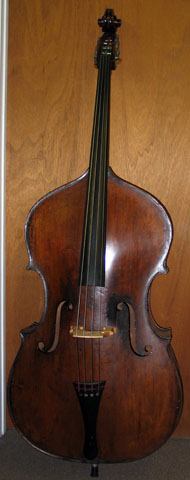 |
 |
 |
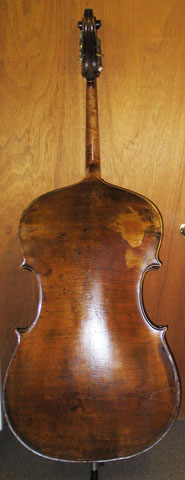 |
Hawkes & Son Early 'Concert' Model Double Bass ~ c. 1894 ~ 3-String Model Converted to 4-Strings ~ |
| Hawkes & Son Roundback 'Concert' Double Bass | |
| Upper Bout: 21 3/4" | Belly Length: 44 1/4" (44 1/2" Back to top of Botton) |
| Center Bout: 15 1/2" | String Length: 42" |
| Bottom Bout: 26 1/4" | Varnish: Golden Brown |
| Rib Depth: 8 7/8" (*measured inside Top & Back, 5 3/8" at the Neck), *add about 1/2" to include the Top & Back | |
| Top: 2 piece fine grained Spruce | |
| Back: Highly flamed Maple | |
| Ribs: Highly flamed Maple | |
| Neck / Scroll: Flamed Maple English Style Scroll with Highly flamed Maple Neck Graft | |
Features: This Bass was originally a 3-string model which was common in London at the time of its making and looks to have been converted to a 4-string early in its life. This Panormo/Maggini combined model has that 'English' sound throughout all its registers. It's a great Orchestra Bass and a killer Jazz Bass as well. A great all around/all purpose Bass is what I would call it as it does just about any job. With its deep Ribs the angled Panormo-style Round-Back makes it easier to handle than the normal upper back Taper. Note: This Bass was originally stamped #2707 in the inside bottom of the Pegbox but was cut away when the new Neck was recently Grafted. Looking at other numbers with dates found on Basses by Hawkes & Son we estimate this instrument to have been made no later than 1894-1895. The production of the Panormo-style model started around 1889-1890 after the dissolve of the Riveire-Hawkes partnership. Three basic models were made. The Panormo and Concert models with round back and the Professor with flat back. All of the flat back models I have seen are of German make. The Concert models were made in both Germany and France. The German model was made with outside linings. The French model looks nearly identicly to the Panormo model but I think we have different dates on them. Perhaps the first models were French made after the dissolve of the Riviere partnership. Later production was shifted to Germany for higher production and lower cost. Just my speculation. What was actually made or finished in England remains a mystery to me. The wood used on this bass is as good or better than any English 'made' 'H' Panormo Model. The difference they say between the Concert and Panormo is mainly the grade of wood used. They could not have found nicer looking wood than was used on this Bass. The fact the the outer linings are uneven in spots suggests this Bass was handmade. One dealer in London has claimed to have all 3 models pass thru his shop that were made in England. One thing to remember when looking at labels is that the address of ALL the Hawkes produced Basses from the beginning had a London address. That is not to say they were of English make but rather made 'for' and sold 'by' an English Firm. The production locations of these Panormo shaped copies are still somewhat of a mystery as to where the various versions were made. The ones with the purfled 'H' under the Back Button are reported to have been made in England. The ones with a purfled 'F' in the upper Back are French in make and although look the same on the outside, the internal work and Varnishing is French in nature. Both of these are Roundbacks. The round and flatback models with the Purfled Loop under the Button are German made from what I have been told. Raymond Elgar mentions that it was a man named Robert Green who was head of the Bass or String department at Hawkes adapted this model after the dissolve of the Riviere partnership of which French Basses were then being made in Mirecourt by the Jacquet-Barbezant firm. These were French Vuillaume model Basses that had nothing to do with the later adapted Panormo pattern. Joseph Jacquet, the youngest of 3 brothers (Gabriel Xavier, Gabriel and Joseph, sons of Joseph Xavier Jacquet) worked with his middle brother Gabriel before teaming up with Frederic Barbezant (reportedly a brother-in-law) to make Basses. The shops in France and Germany as well as England that produced Basses for the Hawkes Firm is still unknown to this date. Many speculations exist out there depending on which 'expert' you ask. This Bass #2707 shows a mix of English, French, and German in its design and make. If this is German made, then it's a fine example. This Bass has been Sold. |
|
 |
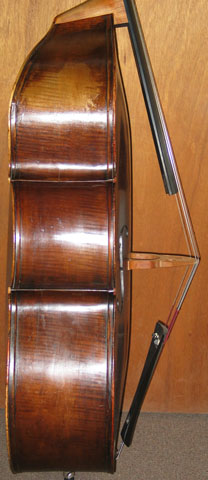 |
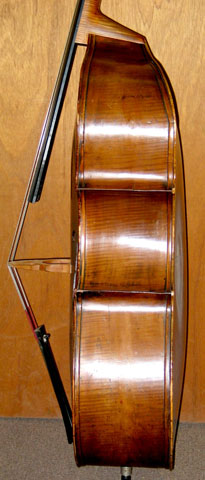 |
 |
| This particular Hawkes & Son Double Bass is a bit lighter in weight than other Hawkes Basses I have seen. Perhaps this early made model was not quite as heavily wooded as some of the later produced Basses were. The outer Linings on this Bass taper at the Neck on the Back side edge. The C-bout Linings also seem to be somewhat less than uniform with the upper and lower Linings. This is something I have not seen before on German work. |
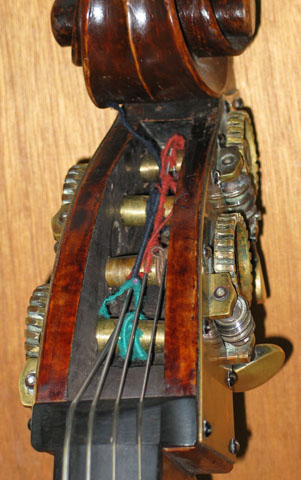 |
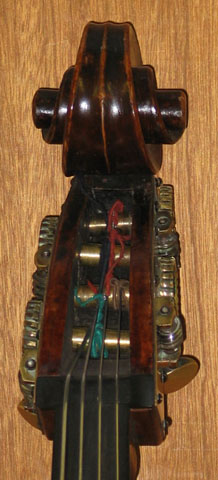 |
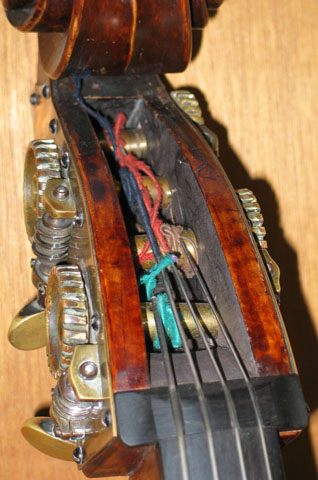 |
| The original middle Gear from its 3-string life can be seen by the plugs shown on either side of the inside cheeks in the middle. |
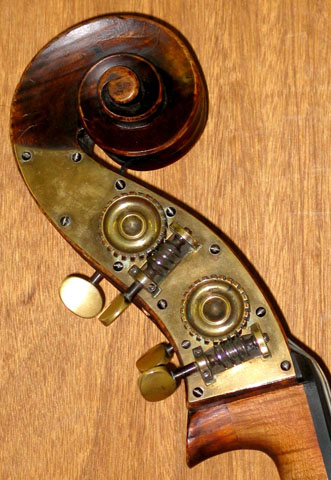 |
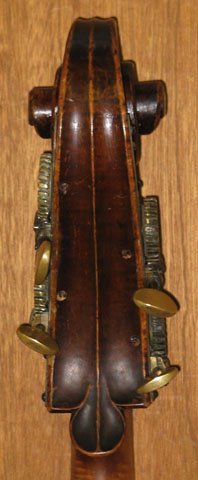 |
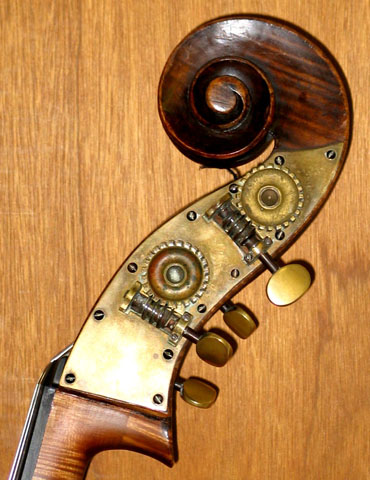 |
|
The rear of the Peg box shows how these early Mirecourt Gear posts were pinned with a screw. The D-Gear was added when it was converted from 3 to 4-strings early in its life. Only the E-Gear (formerly an A?) remains in its original position as the other two original Gears have been obviously repositioned to accommodate 4 machines when it was converted. Although the Gears and Gear Worms are obviuosly French, the buttons/handles are English Baker models. The Gear Plates are actually inlaid 'over' the worm mountings which is actually part of the 3-4 string conversion and looks to be of English work. |
 |
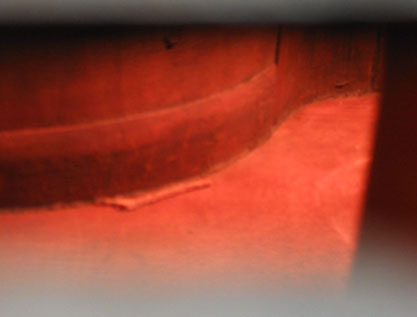 |
| An inside view of the Back showing the original Back joint studs, Neck Block and wider than normal internal Linings. This is usually a French feature as the Jacquet Bass we just acquired has similar internal Linings to this Hawkes Bass. |
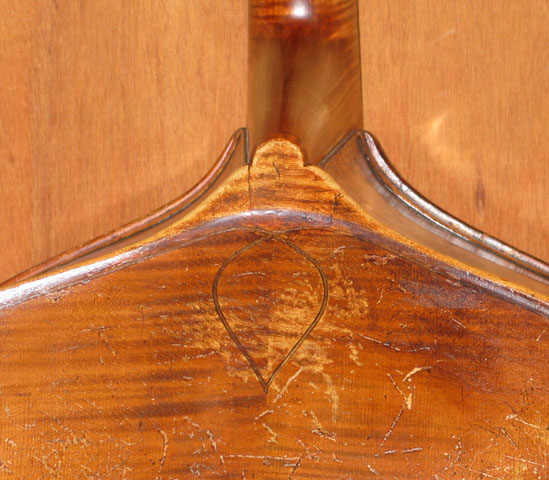 |
| An inlaid Loop design in the upper Back seen here showing the style and width of Purfling that was used. |
 |
Copyright © 1998-2010 Ken Smith Basses, LTD. (All rights reserved) ALL PRICES AND SPECS SUBJECT TO CHANGE WITHOUT NOTICE |
 |